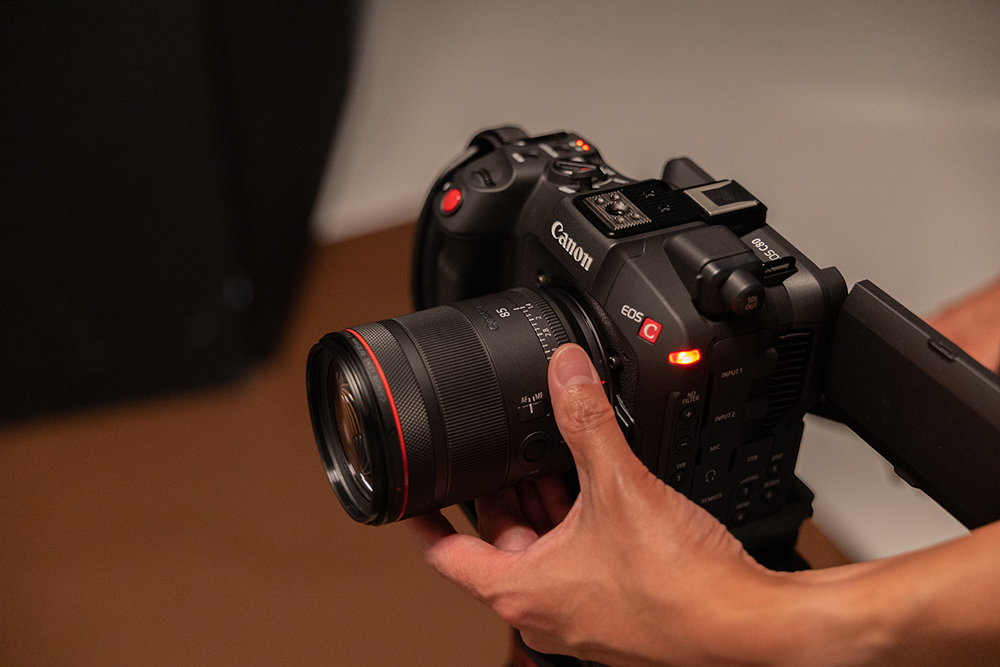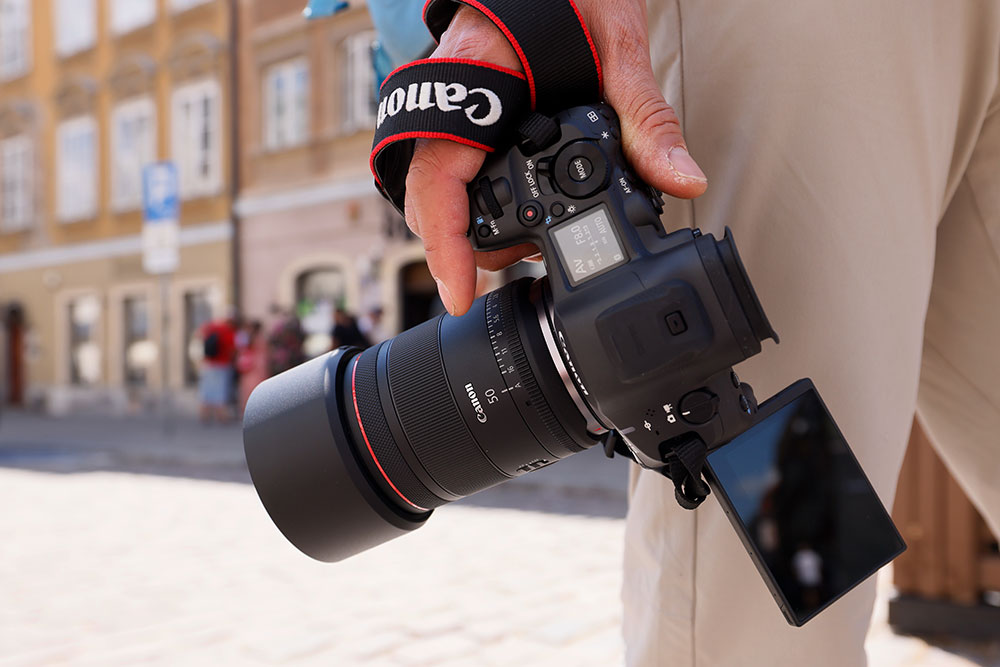- Your comprehensive guide to hybrid lenses
-

A Canon Hybrid Lens is designed for creators who shoot both photos and videos – and want professional results. These lenses combine features from both Canon’s photo and cinema lines, giving you the best of both worlds in a single, versatile lens.
Whether you're capturing a wedding, filming a travel vlog, or shooting a cinematic short, hybrid lenses are built to adapt – with fast autofocus, cinematic bokeh, consistent handling, and video-first features so that you could carry less lenses, but still achieve amazing results.
Before hybrid lenses, creators often had to choose between:
• Photo-first lenses (fast AF, but not smooth for video)
• Cinema lenses (beautiful for film, but bulky and expensive)
Canon’s hybrid lenses are built for the modern creator – with unified design, reliable focus, and advanced video tools, they’re like having two lenses in one.
Get to know Canon’s current range of hybrid RF lenses:
| Lens | Key Specs | Ideal For |
| RF 24-105mm f/2.8L IS USM Z | Versatile zoom, power zoom compatible | Weddings, events, documentary |
| RF 70-200mm f/2.8L IS USM Z | Long telephoto, compact & stable | Sports, nature, cinematic interviews |
| RF 24mm f/1.4L VCM | Wide-angle, bright aperture | Landscape, cityscapes, walk-and-talk video |
| RF 35mm f/1.4L VCM | Classic storytelling focal length | Interviews, handheld video, portraits |
| RF 50mm f/1.4L VCM | Standard focal length, creamy bokeh | Portraits, low-light, cinematic shallow depth of field |
| RF 85mm f/1.4L VCM | Natural-looking compression, tight framing | Detail shots (such as products or hands), concerts |

All hybrid lenses are designed to share a standardised form factor so you can swap between them without rebalancing your rig or gimbal. That means:
• Faster setup between shots – perfect for fast-paced environments where there’s no time to rebalance or recalibrate your setup.
• Shared filter sizes = less gear – ND filters, mist filters, and polarisers can be used across lenses, saving weight, cost, and complication.
• More time capturing, less time adjusting – efficiency in the field means you can stay focused on the story, not the setup.
This consistent lens sizing extends across both zoom and prime lenses in the hybrid range. So whether you're switching from the 24-105mm to 70-200mm, a 20mm to a 85mm prime on a gimbal, your gear stays balanced, stable and ready to roll.
It also means interchangeability without interruption – easily swap lenses without adjusting your setup or disrupting your creative flow.
And because the lenses share similar weights and handling, you'll enjoy consistent ergonomics, making it easier to maintain grip, balance, and shooting confidence across your entire kit.
Whether you’re packing your bag or pulling gear on the go, unified filter threads mean fewer accessories to juggle – saving you time, cost, and space in your kit.
Ideal for: solo shooters, gimbal users, event creators, wedding filmmakers, travel vloggers – anyone who needs a flexible and fast lens workflow with minimal interruption.
When a lens “breathes”, it shifts perspective during focus pulls which can be distracting in video. Hybrid lenses are engineered to suppress focus breathing.
• Dual Nano USM motors (on zooms) – fast, accurate, near-silent autofocus performance that keeps your subject sharp without compromising the background or composition.
• New Voice Coil Motor (on primes) – the VCM operates independently of the Nano USM to offer even finer control over focus shifts, particularly valuable in manual focus or narrative work.
The result is smooth, quiet, controlled focus – especially crucial when filming in motion or tracking subjects. You'll notice cleaner, more cinematic focus transitions that preserve the integrity of your frame. This is particularly powerful for storytelling where focus pulls are used deliberately to guide viewer attention.

Hybrid lenses feature large constant apertures – f/2.8 on zooms and a wide f/1.4 on primes.
• Let in more light for low-light shoots – capture clean footage at dusk, indoors, or on location without introducing noise.
• Create beautiful background blur – ideal for isolating your subject, guiding the eye, and adding cinematic depth to your scenes.
• Reduce reliance on ISO (less noise) – maintain image quality while retaining colour and detail in both photo and video.
The f/2.8 zooms provide the speed and flexibility needed for events, sports, or fast action scenes – while the f/1.4 primes take things further, enabling ultra-shallow depth of field, soft bokeh, and high-impact creative control.
Whether you’re filming at sunset, shooting handheld in a dimly lit venue, or framing a close-up interview, these lenses offer the visual richness and flexibility that today’s hybrid creators demand.

Canon hybrid lenses aren’t just about image quality – they’re about usability. The hybrid RF lenses are equipped with the same controls to suit the versatile needs of creators switching from photo and video.
• Smooth-turning Iris ring (for manual aperture control) – found on the primes, this allows precise and silent control over your exposure while filming.
• Rear filter slot (on primes) = better image quality, fewer vignettes – use ND or diffusion filters behind the lens to preserve optical performance and reduce front-heavy setups.
• Power zoom compatibility (on zooms) for pro-level zoom pulls – achieve smooth, consistent zooms ideal for narrative or documentary work.
• Fixed-length zooms = consistent balance on gimbals – the barrel doesn’t extend while zooming, so your rig stays perfectly balanced throughout the shot.
Zoom models like the RF 24-105mm f/2.8L USM Z and RF 70-200mm f/2.8L USM Z feature:
• Fixed physical length for stable handling and reduced shake
• Power Zoom Adapter support for fluid zoom transitions
• Compatibility with RF extenders (1.4x and 2x) – giving you up to 400mm reach without swapping lenses
Prime lenses like the RF 35mm f/1.4L VCM and RF 50mm f/1.4L VCM include:
• Manual iris rings for on-the-fly video exposure control
• Rear filter holders to support cinematic glass filters and enhance image purity
Every detail is designed to make switching between photo and video feel effortless – and to keep your setup streamlined, no matter the shooting environment.

As part of the Canon L-series, these lenses are:
• Weather sealed to handle tough conditions – protection against dust and moisture when shooting in harsh conditions with enhanced optical quality to minimize aberrations
• Durable construction built for daily use – premium materials ensure a long lifespan and robust build quality
• Backed by Canon’s 5-year warranty – shoot with peace of mind knowing exceptional support is provided in the years to come
You’re not just getting flexibility – you’re getting reliability. Whether you’re out in the field or on a fast-paced commercial set, Canon’s hybrid lenses are engineered to withstand the pressure while delivering consistently outstanding results.
Hybrid lenses are made for:
• A wedding shooter who need to switch between stills and film during the same event
• Content creators shooting short-form, reels, or vlogs on the go
• Commercial shooters working agile with a mirrorless setup on small crews
• A run-and-gun filmmaker wanting to eliminate having to switch lenses every time
• Professional photographers looking to expand into high-quality video
If you’re using a Canon mirrorless camera- these lenses can help unlock your potential.
Hybrid lenses are perfect when you need both. They don’t replace every tool – but they fill the gap better than anything else available.
Read more about how creators have put Canon hybrid lenses to the test. Whether it’s switching seamlessly between stills and video on set, or streamlining gear for travel shoots, creators are discovering how hybrid lenses can simplify their setups without sacrificing quality.
Explore how hybrid lenses are being used in the field →
| KEY SPECS | RF 24-105mm f/2.8L IS USM Z | RF 70-200mm f/2.8L IS USM Z | RF 24mm f/1.4L VCM | RF 35mm f/1.4L VCM | RF 50mm f/1.4L VCM | RF 85mm f/1.4L VCM |
| Mount | RF | RF | RF | RF | RF | RF |
| Focal Length | 24-105mm | 70-200mm | 24mm | 35mm | 50mm | 85mm |
| Maximum Aperture (f) | f/2.8 | f/2.8 | f/1.4 | f/1.4 | f/1.4 | f/1.4 |
| Lens Construction (elements/groups) | 23/18 | 18/15 | 15/11 | 14/11 | 14/11 | 10/14 |
| Aperture Blades | 11 | 11 | 11 | 11 | 11 | 11 |
| Minimum Focusing Distance (m) | 0.45m | 0.49m | 0.24m | 0.28m | 0.4m | 0.75m |
| Maximum Magnification | 0.29x | 0.3x | 0.17x | 0.18x | 0.15x | 0.12x |
| Dust and Water Sealing | Yes | Yes | Yes | Yes | Yes | Yes |
| Filter Diameter (mm) | 82mm | 82mm | 67mm | 67mm | 67mm | 67mm |
| Image Stabilization | Yes (5.5 stops) | Yes (5.5 stops) | No | No | No | No |
| Focus Drive System | Dual Nano USM | Dual Nano USM | VCM + Nano USM | VCM + Nano USM | VCM + Nano USM | VCM + Nano USM |
| Dimensions (mm) | 88.5 x 199mm | 88.5 x 199mm | 76.5 x 95.3mm | 76.5 x 95.3mm | 76.5 x 95.3mm | 76.5 x 95.3mm |
| Weight (g) | 1330g | 1110g (white) / 1115g (black) | 515g | 555g | 580g | 636g |
In summary, these lenses set a new standard for creativity in the hybrid photo and video age – from the external look to the internal design. With the increasing number of creators working either alone or in smaller teams, a dual-purpose lens for both mediums not only simplify the workflow but expands the creative possibilities of photo and video.
Find out more about our latest products.

Fashion photographer Steven Chee shows how Canon hybrid lenses capture both stills and motion with speed, versatility and style.

Mirrorless vs Cinema Camera: When to Make the Switch

Discover the top 5 features of EOS C50 that make it an ideal camera for cinematic video and hybrid content creation.